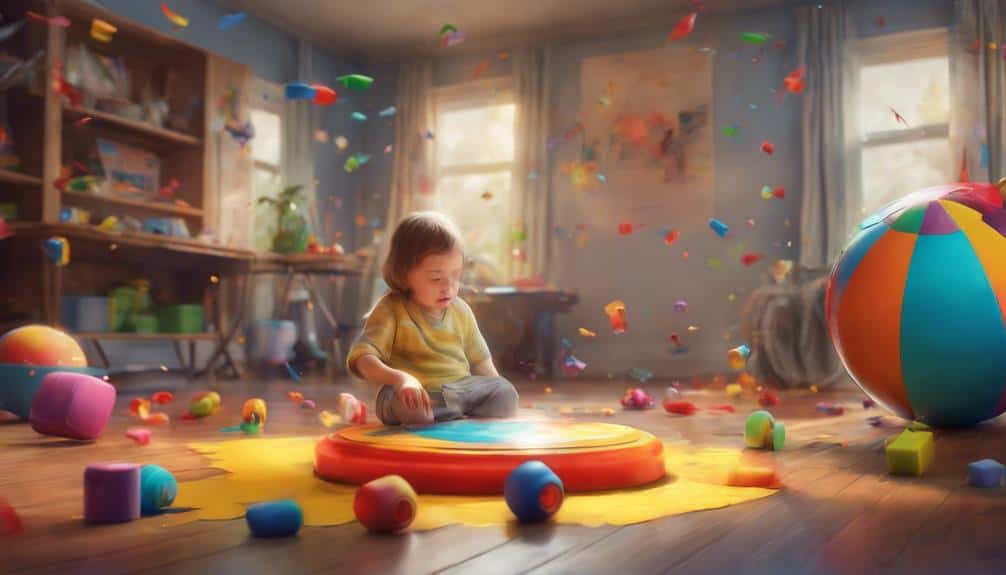Autism Spinning Toys
I must say, the impact of autism spinning toys on children with autism spectrum disorder is truly remarkable.
The way these toys can captivate attention and foster engagement is something worth exploring further.
The benefits they offer go beyond mere entertainment, providing a unique avenue for development and support.
Let's investigate how these specialized toys can make a difference in the lives of individuals on the autism spectrum.
Key Takeaways
- Spinning toys aid sensory development and learning in autism.
- Enhance focus and concentration through mesmerizing sensory experiences.
- Manage sensory overload effectively with calming spinning toys.
- Promote inclusive educational development tailored to unique needs.
Benefits of Autism Spinning Toys

When exploring the benefits of autism spinning toys, one immediately recognizes their significant impact on sensory development and learning for children on the autism spectrum. These spinning toys, like the Whirly Squigz, not only provide visual and tactile sensory stimulation but also contribute to the enhancement of fine motor skills. The spinning motions and tactile ridges on the toys offer children with autism a unique way to engage their senses while simultaneously working on their hand-eye coordination and dexterity.
As a parent or caregiver, witnessing a child's progress in mastering the spinning toy can be incredibly rewarding. The concentration and focus required to manipulate the toy foster essential skills that can translate into other areas of the child's development. Additionally, the interactive nature of these toys promotes engagement and can support educational growth through hands-on learning experiences. Whether used at home, in school, or during therapy sessions, autism spinning toys offer a versatile tool for sensory play and skill-building tailored to the needs of children with autism.
Sensory Stimulation and Autism

As someone who cares for a child with autism, understanding sensory needs is essential. Finding effective stimulation strategies can make a significant difference in their daily experiences.
Exploring sensory toys like spinning ones can offer valuable support in promoting engagement and development.
Sensory Needs in Autism
Children with autism often benefit from sensory stimulation to support their unique sensory needs and development. Sensory exploration and tactile engagement play an essential role in enhancing their fine motor skills, providing visual stimulation, and promoting educational development through interactive play.
Spinning toys like Whirly Squigz offer a combination of visual and tactile sensory stimulation that can captivate children on the spectrum. The spinning motion and textured surfaces of these toys encourage engagement, focus, and concentration, aiding in tactile learning experiences for children with autism.
Stimulation Strategies for Autism
Utilizing sensory stimulation strategies is essential in supporting individuals with autism in their development and sensory exploration.
Spinning toys like the Whirly Squigz offer a unique way to engage children on the autism spectrum in sensory play experiences. These toys not only encourage sensory exploration but also aid in the development of fine motor skills.
By providing tactile learning opportunities, spinning toys enhance focus and concentration in children with autism. The interactive nature of these toys promotes educational development by creating engaging play experiences that can be beneficial in various settings, from home to school or therapy environments.
Incorporating spinning toys into sensory stimulation routines can greatly benefit children with autism in their overall growth and well-being.
Improving Focus With Spinning Toys

In exploring ways to enhance focus in children with autism, spinning toys like Whirly Squigz offer a mesmerizing and engaging sensory experience. These toys provide not only entertainment but also therapeutic benefits that can aid in improving concentration and attention span.
Here are some ways spinning toys can help improve focus:
- Enhanced Focus: The visual and tactile sensory stimulation from spinning toys can help children with autism concentrate better.
- Sensory Engagement: The spinning motion of these toys can captivate children, promoting sustained attention.
- Promotes Concentration: Spin discs and similar toys offer a fun way for children to explore cause and effect relationships, encouraging focus.
- Regulating Attention: Sensory play with spinning toys can assist in regulating attention, making it easier for children to engage in educational activities.
- Supports Development: Incorporating spinning toys into therapy or learning environments can support children in developing and maintaining focus during tasks.
Utilizing spinning toys as tools for focus enhancement can make a significant difference in helping children with autism stay engaged and attentive.
Managing Sensory Overload Effectively

When it comes to managing sensory overload effectively, it's important to have the right tools in place. Sensory tools like fidget spinners, noise-canceling headphones, and visual schedules can make a world of difference.
Sensory Tools for Calming
Spinning toys offer a soothing solution for managing sensory overload effectively in children with autism. These sensory tools play an important role in promoting sensory regulation, aiding in autism therapy, and serving as fidget tools to enhance focus and relaxation.
Here are five key benefits of using sensory tools like spinning toys:
- Provide calming sensory input through visual stimulation and tactile feedback.
- Encourage focus, concentration, and relaxation for individuals on the autism spectrum.
- Designed to promote self-regulation and reduce anxiety in children with sensory processing challenges.
- Support individuals in coping with overwhelming sensory environments.
- Enhance overall well-being by helping individuals with autism regulate their sensory experiences effectively.
Noise-Cancelling Headphones
To effectively manage sensory overload in children with autism, utilizing noise-cancelling headphones can greatly reduce external auditory stimuli and create a quieter, more comfortable environment for improved focus and relaxation. These headphones are designed for noise reduction, enhancing auditory comfort and aiding in sensory regulation. By blocking out background noise, they help children with autism navigate noisy surroundings more comfortably.
Some models even offer customizable settings to tailor the noise levels to individual preferences, making them versatile tools for creating calmer sensory experiences. Therapists and parents often recommend noise-cancelling headphones as they can greatly benefit individuals with sensory sensitivities. Providing a sanctuary from overwhelming sounds, these headphones play a critical role in supporting children with autism in various environments.
Visual Schedules for Routines
Managing sensory overload in children with autism can be effectively handled through the use of visual schedules, which provide structured routines to enhance predictability and reduce anxiety. Visual supports play an important role in routine management and sensory regulation for individuals with autism. Here are some key points to think about:
- Visual schedules use pictures, icons, or words to outline daily activities and changes.
- They offer predictability and reduce anxiety by showing what comes next in a clear, organized manner.
- These tools support communication, independence, and understanding of expectations.
- Implementing visual schedules at home, school, or therapy settings can improve behavior.
- They promote a sense of security for children with autism and help them navigate their environment more effectively.
Autism Spinning Toys for Relaxation

When seeking relaxation tools for children with autism, consider exploring the benefits of specialized spinning toys like the Whirly Squigz. These toys offer sensory relaxation through spinning therapy, providing calming engagement for children on the autism spectrum. Designed to engage and soothe, the Whirly Squigz delivers visual and tactile sensory input with its bright colors, tactile ridges, and durable construction. It's a versatile tool suitable for children aged 10 months and up, promoting focus, attention, and fine motor skill development.
The Whirly Squigz is ideal for various settings, including therapy, home, or school environments. Its spinning motion helps children with autism relax and engage with sensory experiences, fostering a sense of calm and security. By incorporating these spinning toys into daily routines, caregivers and educators can support children in finding moments of peace and sensory exploration. Consider adding the Whirly Squigz to your toolkit for promoting relaxation and sensory engagement in children with autism.
Enhancing Concentration Skills

Exploring the benefits of specialized spinning toys like the Whirly Squigz can greatly enhance concentration skills in children with autism through engaging sensory play. Children with autism often face concentration challenges, making it difficult for them to focus for extended periods. However, spinning toys offer a solution by providing sensory engagement that captures their attention effectively.
- Sensory Engagement: The visual and tactile stimulation provided by spinning toys can improve focus and attention in children on the autism spectrum.
- Play Therapy: Utilizing spinning toys during therapy sessions can promote sustained attention and concentration in individuals with autism.
- Attention Span: The interactive nature of spinning toys encourages children with autism to stay engaged, helping them develop longer attention spans.
- Motor Skills: Using spinning toys can also support the development of motor skills while enhancing concentration.
- Interactive Learning: Incorporating spinning toys into educational activities can offer interactive learning experiences that aid in concentration and attention development.
Spinning toys serve as valuable tools in enhancing concentration skills and supporting individuals with autism in their developmental journey.
Supporting Individuals on the Spectrum

Supporting individuals on the spectrum involves recognizing their unique needs and providing tailored interventions that foster growth and development in a safe and inclusive environment.
Sensory exploration plays an important role in the development of children with autism, making spinning toys like Whirly Squigz valuable tools for engaging their senses and promoting sensory play. These toys not only support fine motor skills but also encourage educational development by enhancing focus, concentration, and tactile learning.
The bright colors and tactile ridges of spinning toys are particularly beneficial for highly visual kids on the spectrum, engaging them in sensory exploration and play in a way that suits their preferences and needs. Additionally, the use of food-grade silicone guarantees safety and durability, making these toys reliable for long-term use by children with autism.
Frequently Asked Questions
Why Do Autistic Kids Spin Things?
When overwhelmed, autistic kids may spin things to manage sensory experiences, improve motor skills, and create a calming effect. This repetitive motion can help them refocus, regulate emotions, and feel more in control of their environment.
Do Autistic Kids Twirl?
Twirling can be a common behavior among autistic kids. It helps with sensory processing and motor coordination. Occupational therapy can assist in managing and redirecting this behavior to be more controlled and beneficial for the child.
How Do You Stop Spinning in Autism?
To address sensory overload, I employ strategies like weighted blankets. Social communication challenges are tackled through structured routines. Occupational therapy techniques help regulate spinning behaviors. Collaborating with specialists tailors personalized plans for managing and reducing spinning in autism.
Is Spinning in Circles a Form of Stimming?
Spinning in circles is a common form of stimming. It helps regulate sensory input and manage overwhelming stimuli. Understanding and respecting the need for spinning is vital in supporting individuals with autism. It's about finding comfort and control.
Conclusion
To summarize, autism spinning toys are like colorful whirlwinds that provide a calming oasis in the sensory storm. They help children on the autism spectrum focus, relax, and develop important skills.
With these toys, sensory overload becomes a gentle breeze, and concentration blooms like a vibrant flower. Let these spinning toys be the guiding light in the journey of supporting individuals on the spectrum.







